 W
WThe ailette was a component of thirteenth century knightly armour. Usually made of cuir bouilli, ailettes were thick, quadrangular pieces of leather or wood that attached to the shoulders by means of silk or leather cord. Ailettes were usually flat and nearly rectangular in shape, and usually decorated with heraldic designs.
 W
WArming points are reinforced sections of a gambeson where pieces of armor could be laced on.
 W
WBarding is body armour for war horses. The practice of armoring horses was first extensively developed in antiquity in the eastern kingdoms of Parthia and Pahlava, and after the conquests of Alexander the Great it made its way into European military practices via the Seleucid Empire and later Byzantine Empire. Though its historical roots lie in antiquity in the regions of what was once the Persian Empire, barded horses have become a symbol of the late European Middle Ages chivalry and the era of knights.
 W
WBases are the cloth military skirts, generally richly embroidered, worn over the armour of later men-at-arms such as French gendarmes in the late 15th to early 16th century, as well as the plate armour skirt later developed in imitation of cloth bases for supplemental upper-leg protection, worn by men-at-arms for foot combat.
 W
WA bevor or beaver is a piece of plate armour designed to protect the neck, much like a gorget.
 W
WBoiled leather, often referred to by its French translation, cuir bouilli, was a historical material for various uses common in the Middle Ages and Early Modern Period. It was leather that had been treated so that it became tough and rigid, as well as able to hold moulded decoration. It was the usual material for the robust carrying-cases that were made for important pieces of metalwork, instruments such as astrolabes, personal sets of cutlery, books, pens and the like. It was used for some armour, being both much cheaper and much lighter than plate armour, but could not withstand a direct blow from a blade, nor a gunshot.
 W
WA bracer is a strap or sheath, commonly made of leather, stone or plastic, that covers the ventral (inside) surface of an archer's bow-holding arm. It protects the archer's forearm against injury by accidental whipping from the bowstring or the fletching of the arrow while shooting, and also prevents the loose sleeve from catching the bowstring. They normally only cover part of the forearm, but full-length bracers extending to the upper arm are also available, and other areas have been covered by some archers. In addition, chest guards are sometimes worn, usually by female archers, to protect the breast. With some combinations of non-baggy clothing and bows with a larger distance between the bow and the string, the archer may not need to wear any bracer.
 W
WA brigandine is a form of body armour from the Middle Ages. It is a garment typically made of heavy cloth, canvas, or leather, lined internally with small oblong steel plates riveted to the fabric, sometimes with a second layer of fabric on the inside.
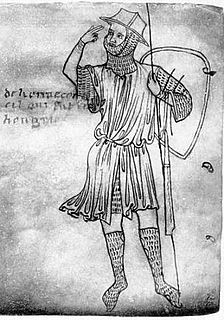 W
WChausses are armour for the legs, usually made from mail. They could extend to the knee or cover the entire leg. Chausses were the standard type of metal leg armour in Europe from the 11th to the 14th century. Chausses offered flexible protection that was effective against slashing weapons. However, the wearer still felt the full force of crushing blows.
 W
WA coat of plates is a form of segmented torso armour consisting of overlapping metal plates riveted inside a cloth or leather garment. The coat of plates is considered part of the era of transitional armour and was normally worn as part of a full knightly harness. The coat saw its introduction in Europe among the warring elite in the 1180s or 1220s and was well established by the 1250s. It was in very common usage by the 1290s. By the 1350s it was universal among infantry militias as well. After about 1340, the plates covering the chest were combined to form an early breastplate, replacing the coat of plates. After 1370, the breastplate covered the entire torso. Different forms of the coat of plates, known as the brigandine and jack of plates, remained in use until the late 16th century.
 W
WA coif is a close fitting cap worn by both men and women that covers the top, back, and sides of the head.
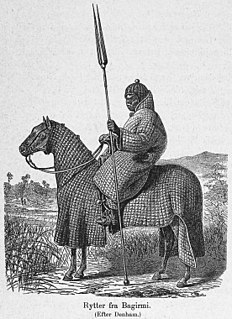 W
WA gambeson is a padded defensive jacket, worn as armor separately, or combined with mail or plate armor. Gambesons were produced with a sewing technique called quilting. They were usually constructed of linen or wool; the stuffing varied, and could be for example scrap cloth or horse hair. During the 14th century, illustrations usually show buttons or laces up the front.
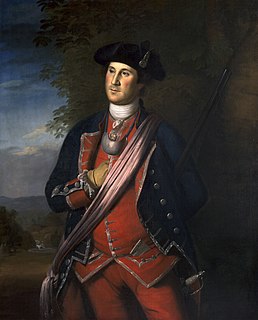 W
WA gorget, from the French gorge meaning throat, was a band of linen wrapped around a woman's neck and head in the medieval period or the lower part of a simple chaperon hood. The term later described a steel or leather collar to protect the throat, a set of pieces of plate armour, or a single piece of plate armour hanging from the neck and covering the throat and chest. Later, particularly from the 18th century, the gorget became primarily ornamental, serving as a symbolic accessory on military uniforms, a use which has survived in some armies.
 W
WGousset was a component of late Medieval armor. During the transition from mail to plate armor, sections of mail covered parts of the body that were not protected by steel plate. These sections of mail were known as gousset. Gousset came into use in the fourteenth century as plate became a structural part of a suit of knightly armor rather than an addition strapped over a suit of mail. During the fourteenth century there was considerable variation in the ratio of gousset to plate.
 W
WA greave or jambeau is a piece of armour that protects the leg.
 W
WA hauberk or byrnie is a shirt of mail. The term is usually used to describe a shirt reaching at least to mid-thigh and including sleeves. Haubergeon generally refers to the quilted undergarment used with a hauberk, but the terms are sometimes used interchangeably.
 W
WA jack chain is a type of chain made of thin wire, with figure-eight-shaped links and loops at right angles to each other. Jack chains are often used to suspend fixtures such as lights or signs, for decorative purposes, or as part of a cable lock.
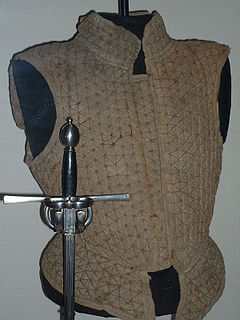 W
WA jack of plate is a type of armour made up of small iron plates sewn between layers of felt and canvas. They were commonly referred to simply as a "jack". This type of armour was used by common Medieval European soldiers as well as by the rebel peasants known as Jacquerie. The present day equivalent is perhaps a bullet-proof vest.
 W
WJazerant, or hauberk jazerant, is a form of medieval light coat of armour consisting of mail between layers of fabric or leather. It was largely used in Turkey, the Middle East, and Persia from the 11th and 12th century, at the end of the 13th and throughout the 14th century. In the following centuries, its use was replaced by that of the jaque, or "jacket", which was a kind of gambeson. Also known as kazaghand, gazarant or gesserant, its name has been variously interpreted but most likely derived from the Arabic jazā’irī, which means "Algerine": the Arabs of north Africa were renowned for their mail coats. The samurai of Japan used a type of jazerant during the Edo period: kusari katabira were constructed with mail sewn between layers of cloth.
 W
WKasten-brust armour — is a German form of plate armour from the first half of 15th century.
 W
WLamellar armour is a type of body armour, made from small rectangular plates of iron or steel, leather (rawhide), or bronze laced into horizontal rows. Lamellar armour was used over a wide range of time periods in Central Asia, Eastern Asia, Western Asia, and Eastern Europe. The earliest evidence for lamellar armour comes from sculpted artwork of the Neo-Assyrian Empire in the Near East.
 W
WLaminar armour is an armour made from horizontal overlapping rows or bands of solid armour plates called lames, as opposed to lamellar armour, which is made from individual armor scales laced together to form a solid-looking strip of armor. Prominent examples of such armour are lorica segmentata of Ancient Rome and certain versions of samurai armour.
 W
WA lance rest is a metal flange that is typically attached to the right side of a breastplate, just under the armpit. The lance rest appeared in the late 14th century, remaining in use until plate armor in general use became obsolete by the early 17th century.
 W
WThis table identifies various pieces of body armour worn from the medieval to early modern period in the Western world, mostly plate but some mail armour, arranged by the part of body that is protected and roughly by date. It does not identify fastening components or various appendages such as lance rests or plumeholders, or clothing such as tabards or surcoats, which were often worn over a harness. The slot in the helmet is called an occularium.
 W
WChain mail is a type of armour consisting of small metal rings linked together in a pattern to form a mesh. It was generally in common military use between the 3rd century BC and the 16th century AD in Europe, and longer in Asia and North Africa. A coat of this armour is often referred to as a hauberk, and sometimes a byrnie.
 W
WMail and plate armour is a type of mail with embedded plates. Armour of this type has been used in the Middle East, North Africa, Ottoman Empire, Japan, China, Korea, Vietnam, Central Asia, Greater Iran, India, Eastern Europe, and Nusantara.
 W
WA mail coif is a type of armour which covered the head. A mail coif was a flexible hood of chain mail that extended to cover the throat, neck and the top part of the shoulders. They were popular with European fighting men of the Middle Ages.
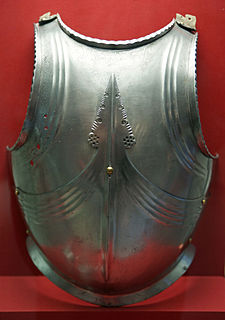 W
WA plackart is a piece of medieval and Renaissance era armour, initially covering the lower half of the front torso. It was a plate reinforcement that composed the bottom part of the front of a medieval breastplate. They were predominantly worn in the 15th century. Sometimes they were worn with a metal finish, while the top part of the cuirass was covered in material, the difference in finish making a contrast.
 W
WThe poleyn or genouillere was a component of Medieval and Renaissance armor that protected the knee. During the transition from mail armor to plate armor, this was among the earliest plate components to develop. They first appeared around 1230 and remained in use until 1650 when firearms made them obsolete.
 W
WThe proofing of armour is testing armour for its defensive ability, most commonly the historical testing of plate armour and mail (armour). In the early Middle Ages, armour would be classified by the blows it could withstand, being certified as proof against swords, axes, and arrows. As firearms emerged as battlefield weapons, armour would be tested against them, as well, from which came the modern term "bulletproof".
 W
WRing armour is an assumed type of personal armour constructed as series of metallic rings sewn to a fabric or leather foundation. No actual examples of this type of armour are known from collections or archaeological excavations in Europe. It is sometimes called ringmail or ring mail. In the Victorian era the term "mail" was used fancifully for any form of metallic body armour. Modern historians reserve the term "mail" for armour formed of an interlinked mesh of metal rings.
 W
WA sabaton or solleret is part of a knight's body armor that covers the foot.
 W
WScale armour is an early form of armour consisting of many individual small armour scales (plates) of various shapes attached to each other and to a backing of cloth or leather in overlapping rows. Scale armour was worn by warriors of many different cultures as well as their horses. The material used to make the scales varied and included bronze, iron, steel, rawhide, leather, cuir bouilli, seeds, horn, or pangolin scales. The variations are primarily the result of material availability.
 W
WSchynbalds were an early experiment in plate armour for the lower leg. Schynbalds were metal plates strapped over chausses. Each schynbald was a single piece of steel that covered the front and outside of the shin. Schynbalds did not enclose the lower leg: hence, they were not true greaves. Schynbalds first appeared in the 1230s or 1250s and remained in use during the fourteenth and fifteenth centuries.
 W
WSpaulders are pieces of armour in a harness of plate armour. Typically, they are a single plate of steel or iron covering the shoulder with bands (lames) joined by straps of leather or rivets. By the 1450s, however, they were often attached to the upper cannon or rerebrace, a feature that continued into the 16th century.
 W
WSplint armour is armour consisting of strips of metal ("splints") attached to a cloth or leather backing. It is most commonly found as limb armour such as greaves or vambraces.
 W
WA standard, also called a pizaine, was a collar of mail often worn with plate armour. It protected the throat and neck and usually extended over the shoulders; it was in use from the 14th to the 16th century. Unlike the similar aventail, it was not attached to a helmet. It was called a standard because the part encircling the neck and throat was able to stand upright without any external stiffening. This part of the standard was composed of links joined 6-in-1, which made it less flexible and also stronger; the usual, more flexible, ratio of mail linking was 4-in-1. The lower, shoulder-covering, part of the standard was of 4-in-1 linked mail. Some standards were decorated with edging in brass or bronze links, and/or were given a zig-zag lower edge (vandyked). Standards were sometimes worn under an aventail, or even a gorget, for extra protection. However, standards were often worn without other neck protection by soldiers who valued an unencumbered facility to move the head over additional protection. Standards were popular with archers, whose mobility was at a premium. Standards were frequently worn with helmets that did not afford integral neck and throat protection, such as the sallet, barbute, and kettle hat.
 W
WThe Statute forbidding Bearing of Armour or Coming Armed to Parliament Act 1313 was enacted in 1313 during the reign of Edward II of England. It decrees "that in all Parliaments, Treatises and other Assemblies, which should be made in the Realm of England for ever, that every Man shall come without all Force and Armour". The statute, which was written in the Anglo-Norman language, goes on to assert the royal power to "defend Force of Armour, and all other Force against our Peace, at all Times when it shall please Us, and to punish them which shall do contrary." It declares that "Prelates, Earls, Barons, and the Commonalty of our Realm... are bound to aid Us as their Sovereign Lord at all Seasons, when need shall be."
 W
WVambraces or forearm guards are tubular or gutter defences for the forearm worn as part of a suit of plate armour that were often connected to gauntlets. Vambraces may be worn with or without separate couters in a full suit of medieval armour. The term originates in the early 14th century. They were made from either boiled leather or steel. Leather vambraces were sometimes reinforced with longitudinal strips of hardened hide or metal, creating splinted armour.
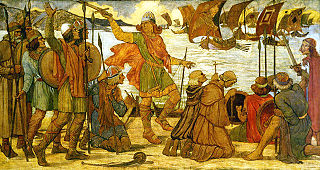 W
WKnowledge about military technology of the Viking Age is based on relatively sparse archaeological finds, pictorial representation, and to some extent on the accounts in the Norse sagas and laws recorded in the 14th century.
 W
WWhite armour, or alwyte armour, was a form of plate armour worn in the Late Middle Ages characterized by full-body steel plate without a surcoat. Around 1420 the surcoat, or "coat of arms" as it was known in England, began to disappear, in favour of uncovered plate. Areas not covered by plate were protected by mail sewn to the gambeson underneath.